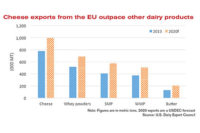Carbon footprints. Greenhouse gas (GHG) emissions. Energy efficiency. The language of sustainability has elicited confusion or even skepticism. But companies that understand and embrace sustainability by implementing sustainable best practices and technologies are experiencing cost savings, operational efficiencies and increased profits. After all, no investment would be sustainable if it did not offer a positive return.
“Sustainability is about caring for the future of the company by making the best use of financial resources and implementing best practices for production,” said David Crowley, environmental, health and safety director for HP Hood LLC, in Lynnfield, Mass.
As a founder of the Innovation Center for U.S. Dairy, the International Dairy Foods Association (IDFA) is helping dairy processors and manufacturers understand what they can do to improve their viability well into the future. Following is some insight for any processor looking to benefit from a commitment to sustainability.
1. Calculate your energy usage and tackle it head-on
In order to know what you want to achieve in a sustainability initiative, you have to know where you stand. Processors and manufacturers typically start by conducting a plant energy audit, which provides an in-depth understanding of a plant’s energy usage and utility costs, said Calvin Wohlert, principal with Solution Dynamics LLC, in Denver, Colo. This knowledge also will be critical for the performance measurement and verification of an established energy-efficiency program.Similarly, the dairy industry as a whole has to understand its own energy usage and environmental impact. The Innovation Center engaged the Applied Sustainability Center at the University of Arkansas to determine the current carbon footprint of fluid milk. Once published, the results of the life cycle assessment will help producers, processors, manufacturers, transportation and distribution and retailers compare their operations with the rest of the industry.
2. Utilize industry resources
Dairy processors can find opportunities to reduce their energy usage through the Dairy Processor Carbon Reduction Through Energy Efficiency (D-CREE) Initiative, which is one of 10 reduction initiatives that will help the dairy industry reach its goal to reduce the GHG emissions of fluid milk by 25% by 2020.Through D-CREE, the Innovation Center is gathering, publishing and promoting milk processing energy-efficiency best practices and case studies, along with associated economic feasibility. The initiative also will develop a customizable simulation tool for fluid milk processing to enable processors to assess individual plants and their future energy reduction opportunities.
3. Adopt a mindset of continuous improvement
Some opportunities to improve energy efficiency can be easy to identify, such as shutting down laptops at the end of the day. Others come with a learning curve, and can be more challenging and expensive to implement. By replacing 300 to 450 watt metal halide lamps in a facility with T5 or T8 fluorescent fixtures, one dairy processor was able to cut wattage usage in half while providing equal or more lumens in the same space.4. Change requires a culture shift
As with a culture of safety, employees on the plant floor need to be passionate about the effort - and conscious of their habits - to make a real impact on cost savings and energy efficiency. Because of its sustainability program, HP Hood generated 150 tons of recycled material in 2008, which resulted in more than $250,000 in savings from fees associated with trash disposal. Also in 2008, Hood reduced its average fuel usage for its fleet of trucks by 5% by increasing truck payload, monitoring mile per gallon fuel use and re-blocking delivery routes to avoid back-tracking.5. Learn by example and share best practices
Processors and manufacturers can drive innovation and highlight simple solutions to energy reduction by sharing both the successes and missteps of their sustainability initiatives. One dairy processor that processes in excess of 300,000 pounds of milk per hour, for instance, was able to save more than $500,000 per year by utilizing boiler economizers to preheat feedwater and increase boiler efficiency.Every sustainability initiative should start by establishing economic criteria, goals and funding, Wohlert said. He suggests an overall long-term reduction commitment that has short-term goals, and steps along the way to showcase incremental successes – both in reduced operating costs and significant GHG reductions.
“Reduction of energy goes directly toward increasing the bottom line net earnings,” Wohlert said. “It is not a question of whether or not you should spend the money - you already are.”
Ultimately, the environmental and economic advantages of being sustainable align closely with the health benefits provided by dairy products. As such, the industry needs to continue to respond to consumer demands and make better use of natural resources. The changes we make today will help to sustain U.S. dairy for generations to come.


